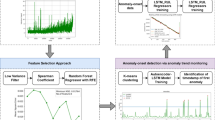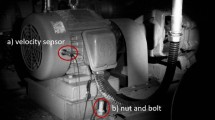Abstract
The large wind generating set works under the varying operation conditions for years, generally the fault characteristic values of the rotary components based on the energy mode is coupled with other noises, so the fault trend can not be accurately predicted. With the wear fault of the high-speed gear of the wind generator as the research object, this paper proposes the trend prediction method of the wear fault of the high-speed gear based on the fusion of ultra-complete independent component analysis (UICA) and parameter estimation (PE), constructs the ultra-complete analysis model, separates the similar source signals more than mixing signals by using the UICA, and finds useful component with the features of the pure similar fault source signal as the basis. Based on the similarity between the similar fault source signal and fault source signal, this paper estimates the value domain of the magnification time of the similar shapes by using the PE, identifies the mapping between continuous and one-way varying magnification time domain and rotary component fault degree, establishes the fault degree judgment standard, and determines and predicts the fault degree and the fault trend based on the energy change trend diagram of the whole-lifecycle fault source signal of the high-speed gear. The above method is used to process the wear fault data of the high-speed gear. The results indicate that the above method has obvious effect in processing of the cycle sudden signals, so it indicates that this method has certain engineering application value and provides reference to solve the problem that the number of the independent vibration sources is more than it of the mixing signals in vibration analysis.






Similar content being viewed by others
References
Xu, X., Wang, H.: Large Rotating Machinery Running State Trend Forecasting. Science Press, Beijing (2011) (in Chinese)
Ar, M., Kar, C.: Fault detection in a multistage gearbox by demodulation of motor current waveform. IEEE Trans. Ind. Electron. 53(4), 1285–1297 (2006)
Casadei, D.: Diagnostic technique based on rotor modulating signals signature analysis for doubly fed induction machines in wind generator systems. In: Proceedings of IEEE IAS’06, Tampa, vol. 3, pp. 1525–1532 (2006)
Inalpolat, M., Kahraman, A.: A theoretical and experimental investigation of modulation sidebands of planetary gear sets. J. Sound Vib. 323, 677–696 (2009)
Dou, D., Zhou, S.: Comparison of four direct classification methods for intelligent fault diagnosis of rotating machinery. Appl. Soft Comput. 46, 459–468 (2016)
Luo, S., Cheng, J., Zeng, M., Yang, Y.: An intelligent fault diagnosis model for rotating machinery based on multi-scale higher order singular spectrum analysis and GA-VPMCD. Measurement 87, 38–50 (2016)
Wei, S., Han, Q., Peng, Z., Chu, F.: Fault feature extraction and enhancement of rolling element bearing in varying speed condition. Mech. Syst. Signal Process. 76–77, 367–379 (2016)
Wang, T., Han, Q., Chu, F.: A new SKRgram based demodulation technique for planet bearing fault detection. J. Sound Vib. 385, 330–349 (2016)
Gui, Y., Han, Q., Chu, F.: A vibration model for fault diagnosis of planetary gearboxes with localized planet bearing defects. J. Mech. Sci. Technol. 30(9), 4109–4119 (2016)
Lei, Y., Liu, Z., Wu, X., et al.: Health condition identification of multi-stage planetarygearboxes using a mRVM-based method. Mech. Syst. Signal Process. 60–61, 289–300 (2015)
Janssens, O., Schulz, R., Slavkovikj, V., et al.: Thermal image based fault diagnosis for rotating machinery. Infrared Phys. Technol. 73, 78–87 (2015)
Omid, G., Xu, J., Zhou, J., Li, X.: Continuous health condition monitoring: a single hidden semi-Markov model approach. In: IEEE International Conference on Prognostics and Health Management, PHM, pp. 1–10 (2011)
Lv, K., Qiu, J., Liu, G., Yang, P.: Real-time health state assessment method for MOSFET based on time stress analysis. In: 2011 Prognostics and System Health Management Conference, PHM (2011). doi:10.1109/PHM.2011.5939537
Xu, X., Chen, T., Minami, M.: Intelligent fault prediction system based on internet of things. Comput. Math. Appl. 64(5z), 833–839 (2012)
Wang, W., Gao, J., Li, Y., et al.: Experimental study about centrifugal compressor axial displacement fault self-recovering system. J. Mech. Eng. 46(5), 49–54 (2010). (in Chinese)
Ogidi, O.O., Barendse, P.S., Khan, M.A.: Fault diagnosis and condition monitoring of axial-flux permanent magnet wind generators. Electric Power Syst. Res. 136, 1–7 (2016)
Antoniadou, I., Manson, G., Staszewski, W.J., et al.: A time-frequency analysis approach for condition monitoring of a wind turbine gearbox under varying load conditions. Mech. Syst. Signal Process. 64–65, 188–216 (2015)
Cross, P., Ma, X.: Nonlinear system identification for model-based condition monitoring of wind turbines. Renew. Energy 71, 166–175 (2014)
Zhang, H., Wang, G., Cai, P., et al.: A fast blind source separation algorithm based on the temporal structure of signals. Neurocomputing 139, 261–271 (2014)
Xu, Y., Deng, X.: Fault detection of multimode non-Gaussian dynamic process using dynamic Bayesian independent component analysis. Neurocomputing 200, 70–79 (2016)
Cai, L., Tian, X.: A new fault detection method for non-Gaussian process based on robust independent component analysis. Process Saf. Environ. Prot. 92(6), 645–658 (2014)
Cai, L., Tian, X., Zhang, N.: A Kernel time structure independent component analysis method for nonlinear process monitoring. Chin. J. Chem. Eng. 22(11–12), 1243–1253 (2014)
Zhang, S., Yao, H., Sun, X., et al.: Action recognition based on overcomplete independent components analysis. Inf. Sci. 281, 635–647 (2014)
Ma, L., Zhang, L.: Overcomplete topographic independent component analysis. Neurocomputing 71(10–12), 2217–2223 (2008)
Wu, Z., Zhang, W., Wang, J., et al.: Feature extraction for gas photoacoustic spectroscopy and content inverse based on overcomplete ICA bases. Opt. Laser Technol. 48, 580–588 (2013)
Acknowledgements
This study was supported by grants from the National Natural Science Foundation of China (51275052 to XU Xiao-li), the Key Project of Natural Science Foundation of Beijing City (3131002 to XU Xiao-li), the National High Technology Research and Development Program (863 Program)(2015AA043702-CS01 to XU Xiao-li), the Project Supported by Beijing Municipal Education Commission (KM201611232020 to JIANG Zhang-lei), the Key Project of Science and Technique Development Plan Supported by Beijing Municipal Commission of Education(KZ201311232036 to XU Bao-jie) and the Beijing Municipal Education Commission Science and Technology Plan Project(KM201411232020 to CHEN Tao). We thanked BIAN Jia-lei and HUANG Ji for their technical assistance.
Author information
Authors and Affiliations
Corresponding author
Ethics declarations
Conflict of interest
The authors declare that there is no conflict of interest regarding the publication of this manuscript.
Rights and permissions
About this article
Cite this article
Zhao, X., Xu, X., Zhao, W. et al. Trend prediction of wear fault of wind generator high-speed gear using a fusion of UICA and PE method. Cluster Comput 20, 427–437 (2017). https://doi.org/10.1007/s10586-017-0733-7
Received:
Revised:
Accepted:
Published:
Issue Date:
DOI: https://doi.org/10.1007/s10586-017-0733-7




